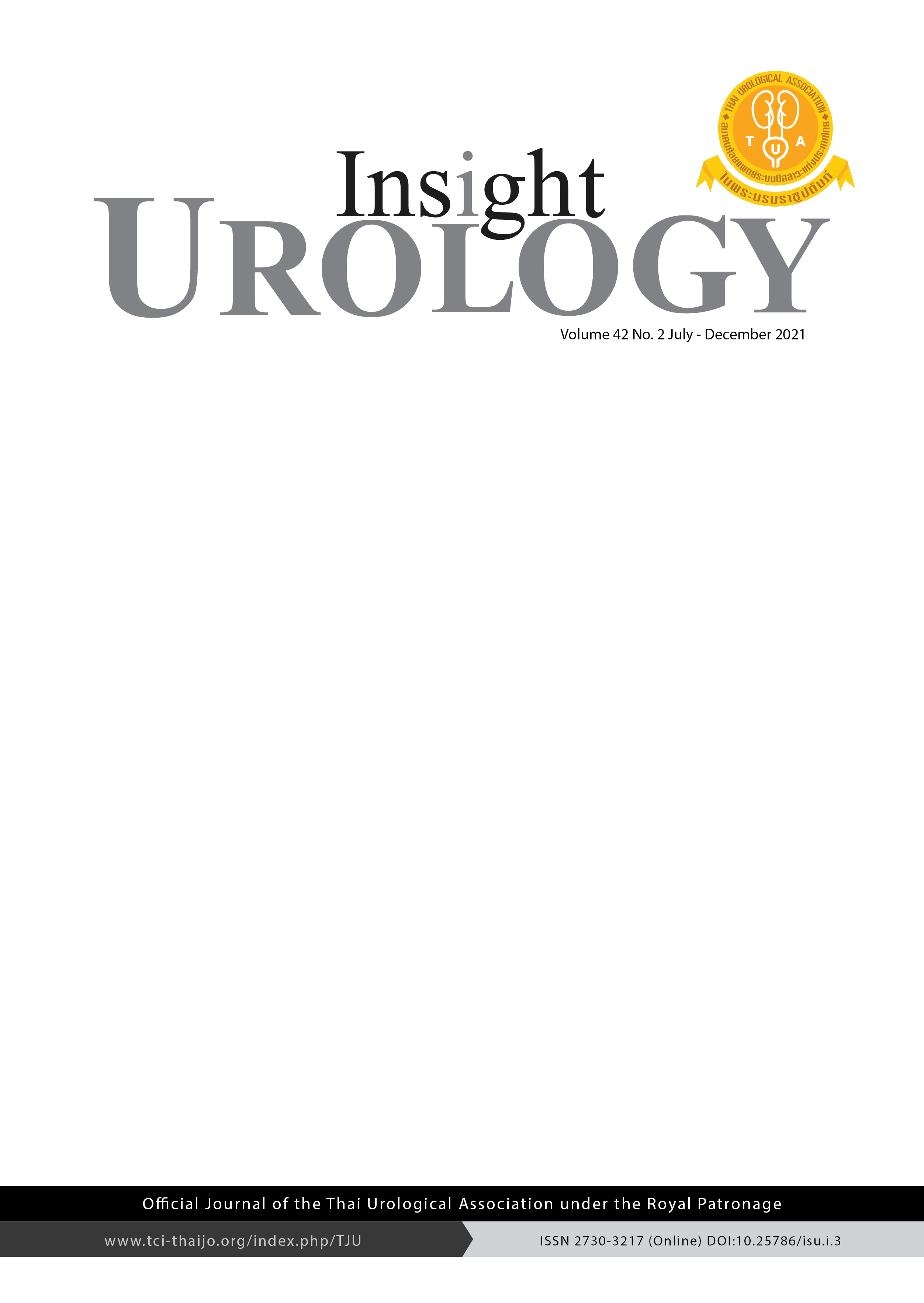A comparison of stone free rate between a diuretic and a control group of patients undergoing extracorporeal shock wave lithotripsy: a prospective, randomized, double-blind, placebo-controlled trial
DOI:
https://doi.org/10.52786/isu.a.36Keywords:
Extracorporeal shock wave lithotripsy, diuretic, stone free rateAbstract
Objectives: To compare the stone free rate and treatment success rate between a diuretic group of patients undergoing extracorporeal shock wave lithotripsy (ESWL) and a control placebo group (normal saline solution).
Materials and Methods: One hundred and ninety-four patients with solitary renal calculi or ureteric calculi size of 5 mm or over were prospectively randomized into 2 groups. Ninety-seven patients in the first group (diuretic group) underwent ESWL after intravenous injection of furosemide 40 mg, and 97 patients in the second (control) group received normal saline solution 4 ml instead of furosemide prior to ESWL. The treatment protocol included 3,000 shockwaves per patient in each session with the energy beginning at 8 and progressing up to 15 kilovolts. A maximum of 3 ESWL sessions were permitted per patient. The primary outcome was stone free rate, and the secondary outcome was treatment success rate at 3 months after the first ESWL treatment.
Results: The stone free rate was 48.5% compared to 50.5% for diuretic group and control group respectively and the treatment success rate was 81.4% compared to 64.9%. The difference in stone free rate was not statistically significantly different (p = 0.87), however the treatment success was, p = 0.01.
Conclusion: A combination of diuretic therapy followed by ESWL improves the treatment success rate compared with standard ESWL therapy alone.
References
Chaussy C, Brendel W, Schmiedt E. Extracorporeally induced destruction of kidney stones by shock waves. Lancet 1980;2:1265-8.
Donaldson JF, Lardas M, Scrimgeour D, Stewart F, MacLennan S, Lam TB, et al. Systematic review and meta-analysis of the clinical effectiveness of shock wave lithotripsy, retrograde intrarenal surgery, and percutaneous nephrolithotomy for lower-pole renal stones. Eur Urol 2015;67:612-6.
Wang Z, Bai Y, Wang J. Effects of diuretic administration on outcomes of extracorporeal shockwave lithotripsy: A systematic review and meta-analysis. PLoS One 2020;15:e0230059.
Sohu S, Soomro MH, Mangrio RH, Shaikh AA, Mirani A, Chand K, et al. Efficacy of extracorporeal shockwave lithotripsy with furosemide and hydration in renal stone management: A randomised controlled trial. Arab J Urol 2019;17:279-84.
EisenmengerW.Themechanismsofstonefragmentation in ESWL. Ultrasound Med Biol 2001;27:683-93.
Augustin H. Prediction of stone-free rate after ESWL. Eur Urol 2007;52:318-20.
Tomomasa H, Kaneko S, Ogawa K, Satoh S, Muramatsu H, Satoh M, et al. Results of extracorporeal shock wave lithotripsy for the treatment of upper urinary tract stones. Hinyokika Kiyo 2007;53:771-6.
Loske AM. The role of energy density and acoustic cavitation in shock wave lithotripsy. Ultrasonics 2010;50:300-5.
Crum LA. Cavitation microjets as a contributory mechanism for renal calculi disintegration in ESWL. J Urol 1988;140:1587-90.
Shin JH, Moon YT. Effects of intravenous fluid and diuretics on stone fragmentation and passage during extracorporealshock wave lithotripsy (ESWL) of upper ureteral stone. Korean J Urol 2003;44:129-33.
Albanis S, Ather HM, Papatsoris AG, Masood J, Staios D, Sheikh T, et al. Inversion, hydration and diuresis during extracorporeal shock wave lithotripsy: does it improve the stone-free rate for lower pole stone clearance? Urol Int 2009;83:211-6.
Al-Ansari A, As-Sadiq K, Al-Said S, Younis N, Jaleel OA, Shokeir AA. Prognostic factors of success of extracorporeal shock wave lithotripsy (ESWL) in the treatment of renal stones. Int Urol Nephrol 2006;38:63-7.
Dong L, Wang F, Chen H, Lu Y, Zhang Y, Chen L, et al. The efficacy and safety of diuretics on extracorporeal shockwave lithotripsy treatment of urolithiasis: A systematic review and meta analysis. Medicine (Baltimore) 2020;99:e20602.
Azm TA, Higazy H. Effect of diuresis on extracor- poreal shockwave lithotripsy treatment of ureteric calculi. Scand J Urol Nephrol 2002;36:209-12.
Sohu S, Soomro MH, Mangrio RH, Mangrio RH, Shaikh AA, Mirani A, et al. Efficacy of extracorpo- real shockwave lithotripsy with furosemide and hydration in renal stone management: A randomised controlled trial. Arab J Urol 2019;17:279-84.
Zomorrodi A, Golivandan J, Samady J. Effect of diuretics on ureteral stone therapy with extracorporeal shock wave lithotripsy. Saudi J Kidney Dis Transpl 2008;19:397-400.
Ahmed AF, Shalaby E, Maarouf A, Badran Y, Eladl M, Ghobish A. Diuresis and inversion therapy to improve clearance of lower caliceal stones after shock wave lithotripsy: A prospective, randomized, controlled, clinical study. Indian J Urol 2015;31:125- 31.
Elkholy MM, Ismail H, Abdelkhalek MA, Badr MM, Elfeky MM. Efficacy of extracorporeal shockwave lithotripsy using Dornier SII in different levels of ureteral stones. Urol Ann 2014;6:346-51.
Thanakhon C, Choonhaklai V. Association of Infundibulopelvic Angle, Infundibuum Width, Infundibulum Length and Lower Pole Ratio on Stone Clearance after Shock Wave Lithotripsy. Thai J Urol 2016;37:19-8.
Prutsakul S, Ramart P, Uraiverotchanakorn A, Nualyong C, Leewansangtong S, Srinualnad S, et al. Aluminium step wedge as a measurement to predict the ESWL success rate for solitary upper urinary tract stone. Thai J Urol 2013;34:19-8.



